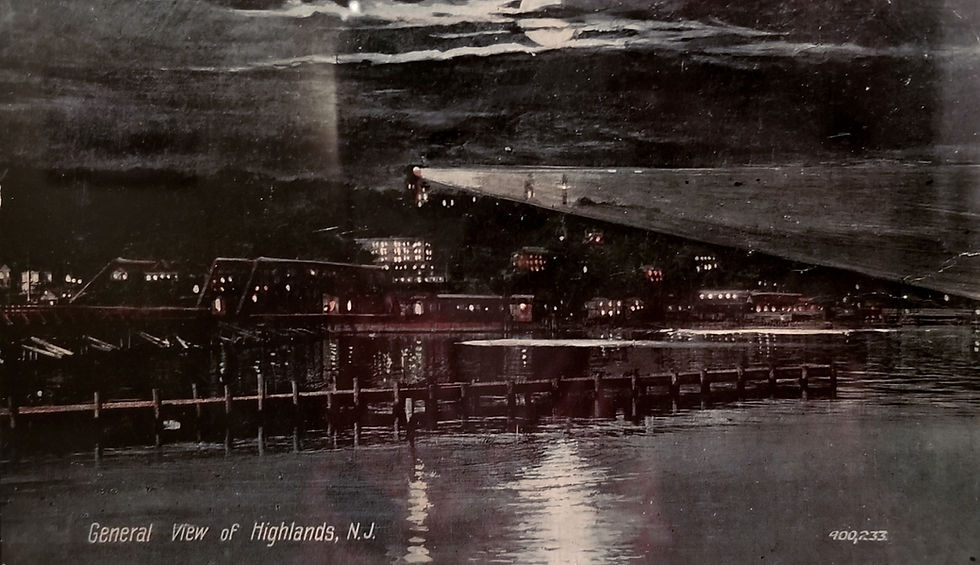The Storm of the Century
- Muriel Smith
- Jun 6, 2021
- 3 min read
Was it a typical day for the lighthouse keeper at the Twin Lights? Hardly. It was the storm of the century.
It was listed as the worst blizzard to ever hit the eastern coast of the United States. It was Jan. 2, 1925, and the storm was described as very much like “a polar bear arriving and departing.” It held the record for the most snow falling recorded in New York at 27.4 inches, a record only eclipsed in 2011 when the records show a total of 36 inches fell.

It was a storm that wreaked havoc everywhere; trains were at stand still, unable to proceed along snow filled tracks, leaving thousands of passengers to sleep in the crowded cars; electricity was out all over the north east, fields of ice of polar proportions blocked ferry service while snowdrifts from ten to twenty feet deep paralyzed transportation With trains and ferries at a standstill, thousands of commuters and other travelers between New York and New Jersey crowded the Hudson and Manhattan tubes as the only means of transportation, gangs of workmen set to work to keep the ferry slips clear while notices were posted advising travelers to use the tubes. Tugs answered shipping distress signals, towing stranded vessels to safer harbors.
Along the Jersey shore, it did not seem quite as fierce, although it proved more deadly. Reports say there was only six inches of snow, but it had been mixed with hail and rain, and heavy winds kept it battering the coast. The British tanker, Ulooloo, ran aground at Sea Bright, but managed to free itself, since there were telegraph reports later in the afternoon the ship passed three quarters of a mile off Asbury Park and appeared to be holding her own.
At the Twin Lights, the guardian of the shore and beacon for those ships at sea, the lighthouse keeper apparently took it all in stride. There is no mention of the raging storm, the electrocution of a man on Bay Avenue in Highlands, nor the wind that must have been whipping through the building. The log for the day said simply, “NE Blizzard. No electric current lighting up time burning vapor lamp.”

The vapor lamp used at the Twin Lights in the early part of the 20th century was most likely the same IOV. incandescent oil vapor light that was used in lighthouses across the country, invented in England and tested by the American Lighthouse Service in 1913, then first used at the Cape Lookout lighthouse in 1913, and improved in 1921. The system called for converting oil into a vapor, mixing it with air to form a gas, then using that to light a material.
At the Twin Lights, oil vapor lamps were used before and shortly after the lights were electrified. They functioned similarly to gas-lit stoves work. The lamp had holes in the top would produce oil vapors which were lit into a flame similarly to a stovetop. The lamps at the Twin Lights typically used kerosene, which came in a wooden the box. Measuring cups were used to measure out the oils to put into the fuel tanks.
Many of the items used in oil vapor lamps are preserved at the lighthouse,, among the thousands of items that go on display during the variety of exhibitions offered at the historic site.
The electrocution in Highlands occurred in late afternoon. Albert Parche, a 40-year old man who owned the Glenwood garage on Bay Avenue, was standing by the door of the garage with an assistance when high winds hit an electric line that contacted a high tension wire and traveled down the garage door Parchen apparently picked up a drop light, was shocked and died. In Port Monmouth, 70-year old Farmer C.H. Mills was taking a short cut through a farm when he was apparently overcome by cold and wind, fell and died, and was not discovered until later that night.
The 1925 storm lasted two days. None of these other events were known to the keeper on the hill. His log on June 3, 1926 simply stated: “Doing our day’s work Cleaned the vapor lamps.”



Comments